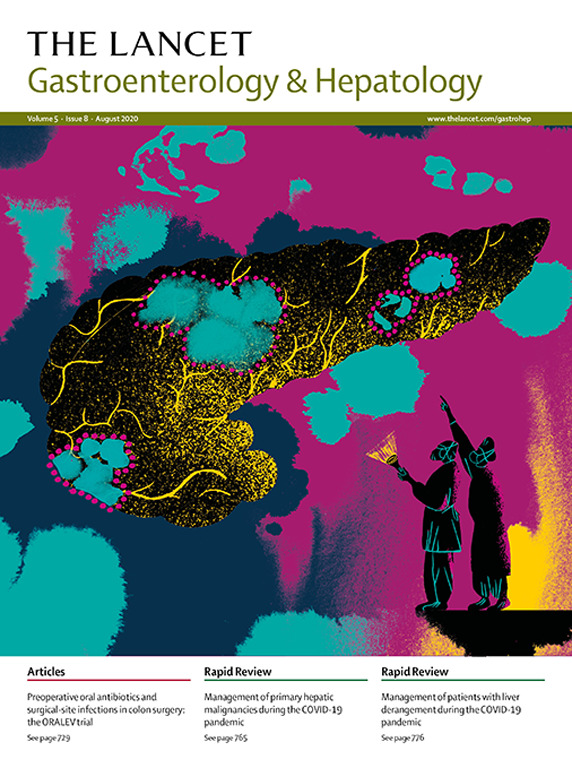Prevalence of hepatitis C virus seropositivity and active infection in a Rohingya refugee population in Cox's Bazar camps, Bangladesh: a cross-sectional study
IF 30.9
1区 医学
Q1 GASTROENTEROLOGY & HEPATOLOGY
引用次数: 0
Abstract
Background
Hepatitis C virus (HCV) infection is a significant public health concern. Limited data have shown unusually high HCV seroprevalence among Rohingya refugees residing in camps in Cox's Bazar, Bangladesh. We aimed to assess the prevalence of HCV seropositivity and active infection and identify risk factors to inform the HCV response.Methods
A cross-sectional survey was conducted between May 10 and June 14, 2023, in adult (≥18 years) residents of seven camps in Cox's Bazar. Households were selected by simple random geosampling and one participant per household was selected at random. Participants were screened for HCV antibodies with a rapid finger prick blood test and, if seropositive, venous samples were tested for HCV viral load. A structured questionnaire collected information about demographics, HCV knowledge, and exposure risks. Survey-adjusted prevalence estimates of HCV seropositivity and active infection were generated by applying sampling weights. Factors associated with HCV seropositivity were identified using univariable and multivariable current status analysis and those associated with active infection via logistic regression.Findings
The survey included 641 participants, of whom 425 (66%) were women and for whom the median age was 34 years (IQR 28–46). 191 individuals tested positive for HCV antibodies. 187 of these individuals were tested for active infection and 124 had a detectable HCV viral load. The survey-adjusted prevalence estimate of HCV seropositivity was 30·4% (95% CI 26·5–34·5), and that of active infection 19·8% (95% CI 16·5–23·4). Current status analysis identified higher odds of HCV seropositivity among individuals reporting medical injection(s) (adjusted odds ratio 1·8 [95% CI 1·2–2·8]) or surgery (5·9 [1·9–18·4]), and among women (2·1 [1·3–3·2]). 328 (51%) of 641 participants had never heard of hepatitis C. Five (4%) of 124 participants with HCV viraemia reported previous HCV treatment.Interpretation
There is a substantial burden of active HCV infection among adult Rohingya camp residents, highlighting the urgent need to scale up testing and treatment capacities. The survey had constraints in identifying risk factors and could not provide data on HCV incidence. Reassessing infection prevalence after mass interventions and prospective surveillance are recommended to monitor ongoing transmission. A well-concerted multi-stakeholder action plan is needed to prevent future large-scale burden of severe liver disease and halt ongoing transmission.Funding
Médecins Sans Frontières.孟加拉国考克斯巴扎尔难民营罗兴亚难民中丙型肝炎病毒血清阳性和活动性感染的流行:一项横断面研究
背景:丙型肝炎病毒(HCV)感染是一个重要的公共卫生问题。有限的数据显示,居住在孟加拉国考克斯巴扎尔难民营的罗兴亚难民中丙型肝炎病毒的血清患病率异常高。我们的目的是评估HCV血清阳性和活动性感染的患病率,并确定危险因素,为HCV反应提供信息。方法于2023年5月10日至6月14日对考克斯巴扎尔7个难民营的成人(≥18岁)居民进行横断面调查。采用简单随机地理抽样法,每户随机抽取1名参与者。参与者通过快速手指刺血试验筛选HCV抗体,如果血清呈阳性,则对静脉样本进行HCV病毒载量检测。一份结构化问卷收集了人口统计学、丙型肝炎病毒知识和暴露风险的信息。经调查调整的HCV血清阳性和活动性感染的患病率估计值是通过应用抽样权重产生的。通过单变量和多变量现状分析确定与HCV血清阳性相关的因素,并通过逻辑回归确定与活动性感染相关的因素。调查结果包括641名参与者,其中425名(66%)是女性,中位年龄为34岁(IQR 28-46)。191人HCV抗体检测呈阳性。其中187人接受了活动性感染检测,124人检测出HCV病毒载量。经调查调整后的HCV血清阳性患病率估计为30.4% (95% CI 26.5 ~ 34.5),活动性感染患病率估计为19.8% (95% CI 16.5 ~ 23.4)。目前的状况分析发现,报告药物注射的个体(调整后的优势比为1.8 [95% CI为1.2 - 2·8])或手术(校正后的优势比为5.9[1.9 - 18.4])和女性(2.1[1.3 - 2])的HCV血清阳性几率较高。641名参与者中有328名(51%)从未听说过丙型肝炎。124名HCV病毒血症参与者中有5名(4%)报告曾接受过HCV治疗。罗兴亚难民营成年居民中存在大量活动性丙型肝炎病毒感染,这突出表明迫切需要扩大检测和治疗能力。该调查在确定危险因素方面存在局限性,无法提供HCV发病率的数据。建议在大规模干预和前瞻性监测后重新评估感染流行情况,以监测正在进行的传播。需要一个协调一致的多利益攸关方行动计划,以防止未来严重肝病的大规模负担,并制止目前的传播。为无国界组织提供资金。
本文章由计算机程序翻译,如有差异,请以英文原文为准。
求助全文
约1分钟内获得全文
求助全文
来源期刊

Lancet Gastroenterology & Hepatology
Medicine-Hepatology
CiteScore
50.30
自引率
1.10%
发文量
0
期刊介绍:
The Lancet Gastroenterology & Hepatology is an authoritative forum for key opinion leaders across medicine, government, and health systems to influence clinical practice, explore global policy, and inform constructive, positive change worldwide.
The Lancet Gastroenterology & Hepatology publishes papers that reflect the rich variety of ongoing clinical research in these fields, especially in the areas of inflammatory bowel diseases, NAFLD and NASH, functional gastrointestinal disorders, digestive cancers, and viral hepatitis.
 求助内容:
求助内容: 应助结果提醒方式:
应助结果提醒方式:


